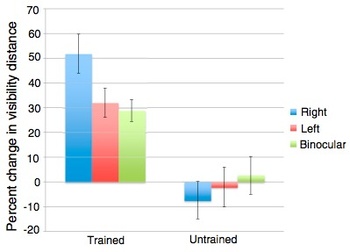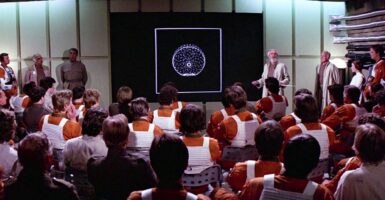Brain-Training App Helps Improve Vision
This article is more than 2 years old
Even though glasses improve one’s hipster cred, some people prefer contact lenses to frames, and others opt for LASIK surgery in an attempt to restore 20/20 vision. But there may be another way: brain-training.
The concept isn’t new. Many neuroscientists are working on ways to improve the brain’s plasticity, which essentially means making the brain more able to absorb and adapt to new information, much like it does when we’re younger. Sometimes, improving plasticity involves popping a pill and sometimes it involves training the brain via games, exercises, or apps. University of California neuroscientist Aaron Seitz, an expert in “perceptual learning,” developed an app called UltimEyes, which promises to “turn back the clock on your vision” by “reversing the effects of aging eyes.” But rather than improving the eyes themselves, it focuses on the cortex, the part of the brain associated with vision. The interactive app is designed to improve one’s visual processing during an eight-week stint in which a user completes four 25-minute sessions a week.
The app is currently available for $5.99 (for a “limited time,” says the website). It can also gather the results from a user’s session so you and your doctor can keep track of the results. The games are designed to elicit high levels of sustained focus, which helps train the brain to process input from the eyes. The app also strives to combine elements of a video game with sounds and visual targets, and tasks designed to get the users to maintain focus even in the face of distractions. So…does it work?

Current Biology published the results of trials conducted on the University of California, Riverside baseball team. Half of the team used the app for 30 sessions, while the other half of the team didn’t use the app at all. Turns out that the players who used the app experienced a 31% improvement in their vision. Seven of them actually improved to the extent that they demonstrated 20/7.5 vision, which means that while the average person needed to be 7.5 feet away from the eye test to read it, the players could read the same line from a distance of 20 feet. The players also said that the app helped their game — they could keep their eyes on the ball better, had better peripheral vision, and an enhanced ability to see other objects.
What’s interesting is both that the app improved their vision, and that those improvements translated to their game. It’s hard to predict how improvements in the vision of the average non-baseball-playing person would manifest, but it sounds like there’s no reason we shouldn’t find out. Among other things, it could help with star-gazing or telling the difference between humans and robots.












